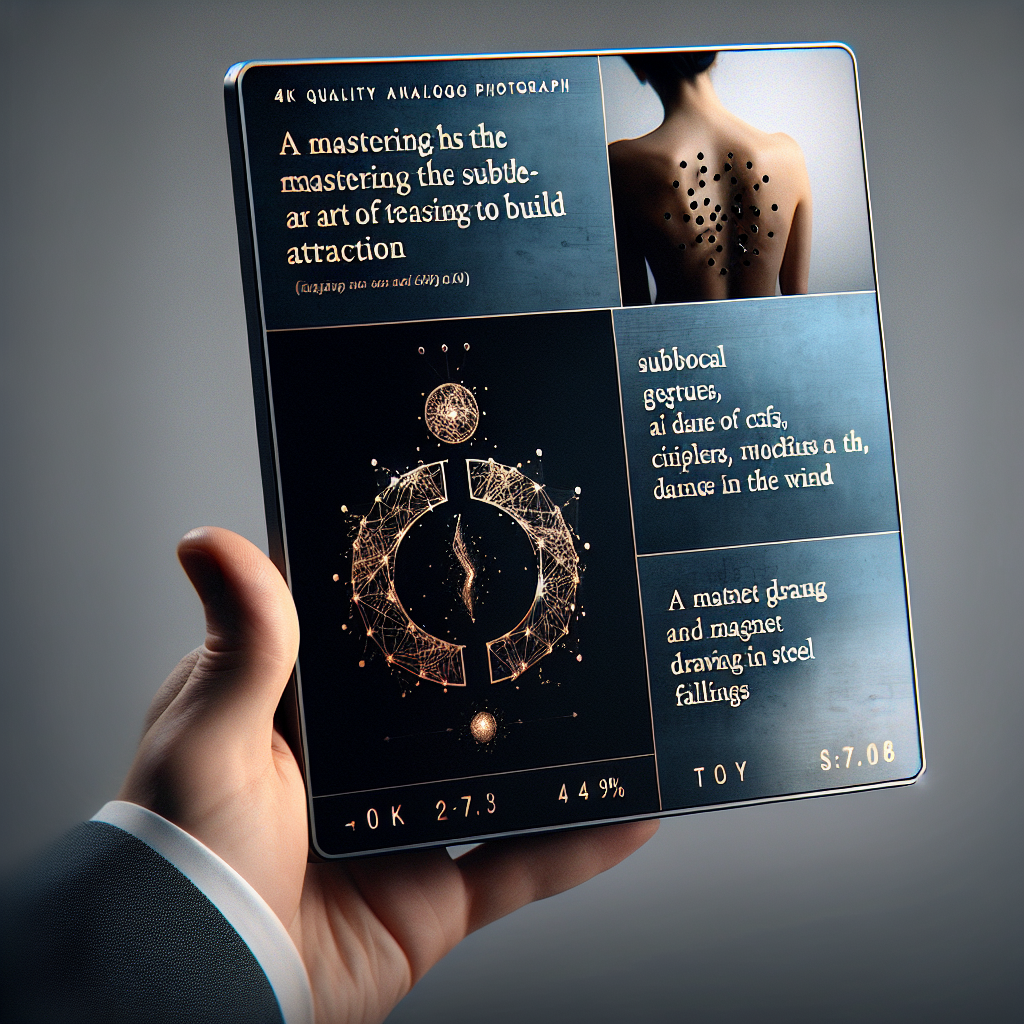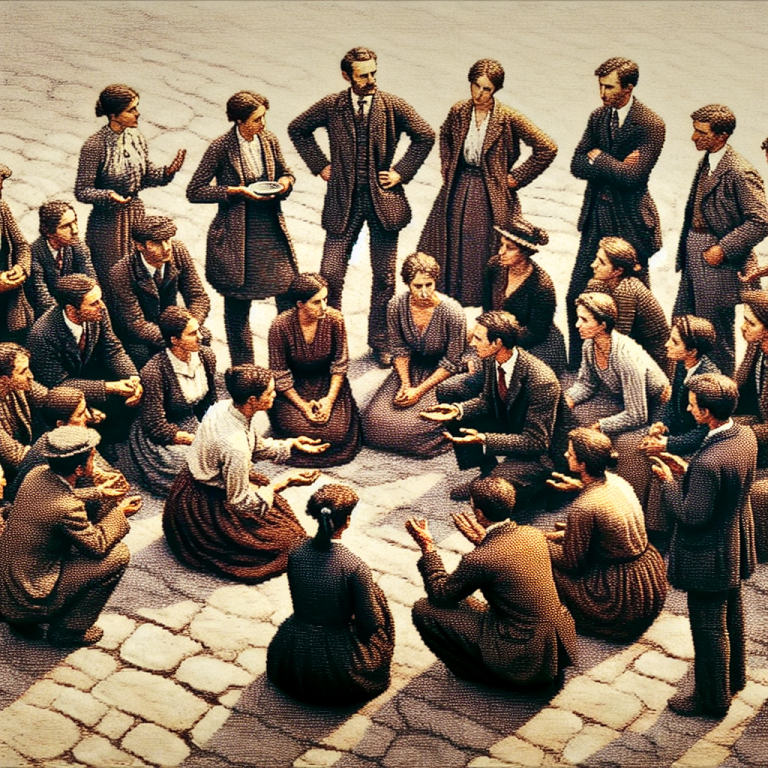How to Master the Subtle Art of Teasing to Build Attraction
Understanding the Basics of Teasing
What Teasing Really Is
Teasing is that playful banter, the light-hearted jabbing of your friends that brings a smile to everyone’s face. It’s important to know that the intention behind teasing should be fun and not malicious. From personal experience, I’ve found that when I tease someone, it’s like adding little sparks to the conversation—igniting a playful spirit that often leads to chemistry. It’s that lightness that draws others in!
This isn’t about making fun of someone; rather, it’s about creating an environment where people feel comfortable and can laugh with you. Remember, the goal is to build connection and attraction, not to hurt feelings. By understanding this nuance, you set the stage for delightful interactions that can escalate into something more.
So, before you start teasing, consider the dynamics at play: Is the person receptive to humor? Do they laugh easily? The more you know your audience, the more effective your teasing will be.
Establishing a Friendly Rapport
One of the biggest keys to successful teasing is having a solid rapport with the person you’re engaging with. From my experience, humor becomes a beautiful form of validation in a relationship. When people feel comfortable around you, they are more likely to respond positively to your playful jabs.
Here’s a trick I often use: build that rapport through authentic conversations. Share a personal story, dive into their interests, and before you know it, you’ll have a friendly connection. Once that’s established, teasing feels more like a beloved inside joke rather than a gamble.
Remember, rapport isn’t built in a day. Be patient, and let those bonds naturally develop before diving into teasing territory.
Understanding Timing and Context
Timing is everything, especially when it comes to teasing! I’ve encountered situations where a well-timed tease brought chaos of laughter, while in the wrong moment, it fell flat. Recognizing those moments when the mood is right can make all the difference.
Pay attention to the conversation flow. If the vibe is light and playful, that’s your golden opportunity! But if the conversation takes a serious turn, that’s your cue to hold back. I’ve learned to read the room, and in doing so, I’ve made more connections than I can count.
Context also matters. Teasing in a group setting might feel different than one-on-one. Adapting to the situation ensures your teasing lands as intended, making it feel personalized and engaging. It’s a dance, and getting comfortable with the rhythm takes practice!
Crafting Your Teasing Style
Finding Your Unique Voice
Your teasing style should feel authentic to who you are. When I first started using teasing as a flirty tool, I tried to mimic others, which never felt right. Instead, I embraced my quirky humor. The key is to be yourself—if you’re more of a sarcastic type, lean into it, but if you’re playful and witty, let that shine!
Don’t be afraid to let your personality seep into your teasing. When it feels natural, others will pick up on that energy. You’ll create a positive feedback loop where they react warmly, and you’ll feel more inspired to continue the flirty banter!
Experiment with different styles. Try light-hearted jibes one day, and sharp wit the next. Over time, you’ll find what resonates best with your audience and makes your teasing more effective.
Being Playful, Not Mean
Let’s face it—there’s a fine line between playful teasing and being mean. I’ve seen friends get carried away, and it can end in hurt feelings. The goal here is to be playful while ensuring that no one walks away feeling self-conscious or down. One way I keep my teasing lighthearted is by always ensuring it aligns with their comfort zone.
A great rule of thumb is to steer clear of sensitive topics. Instead, poke fun at shared experiences or quirky behaviors. For example, if a friend constantly mispronounces a word, you could tease them about it. It’s a gentle nudge, but it works because there’s a shared understanding and respect.
Moreover, always be attuned to reactions. If you sense discomfort, it’s time to back off. You’d be surprised how quickly your teasing can be reoriented into uplifting humor with just a little attention paid to the other person’s feelings.
Adjusting Based on Reactions
This is perhaps one of the most essential skills in the art of teasing—adjusting based on feedback. It’s vital to pay attention to how the other person responds. If they’re laughing, keep going! But if they seem taken aback or uncomfortable, then it’s time to dial it back a notch.
I often take mental notes during interactions. When I notice a consistent reaction, I adjust my approach. If someone loves playful banter, I’ll amp it up, but if they seem to prefer deeper conversations, I’ll switch gears. It’s like becoming a conversational chameleon, adapting to enhance the connection.
At the end of the day, our goal is to connect. By being aware and adaptable, you foster an environment where both of you can thrive. Teasing becomes a bridge rather than a barrier!
Practicing Responsibly and Respectfully
Maintaining Ethical Boundaries
When teasing, one must remember the unspoken ethical guidelines. I often remind myself that while teasing can be a fun tool to build attraction, we should always respect the other person’s boundaries. Communication is paramount.
I make it a point to observe how close I can get with playful teasing. If someone seems uncomfortable, I ease off. Building a relationship should be enjoyable for both parties! It’s crucial to foster an atmosphere of trust and respect, making sure your banter adds value rather than detracting from the connection.
Moreover, it’s essential to have self-awareness. Sometimes, what seems funny to one person can be off-putting to another, and knowing the difference is key. Teasing should be a dialogue of laughter, not a monologue of discomfort!
Being Open to Feedback
Sometimes, we might inadvertently overstep. I remember a time when I made a joke that landed flat with someone I was getting to know. Instead of brushing it off, I asked for feedback. Having that open line of communication not only helped me learn but also strengthened our connection.
Being open to criticism about your teasing style can be transformative. Encourage honest conversations where the other person feels safe expressing their boundaries. It’s a game-changer when both sides are respected and appreciated!
Incorporating feedback into your teasing repertoire can turn those minor missteps into opportunities for growth. After all, everyone grows from shared experiences—teasing included.
Reflecting on Your Experiences
Finally, take time to reflect on your experiences. After engaging in teasing, I often think about what went well and where I can improve. It’s like fine-tuning a skill—practice makes perfect!
Consider journaling your interactions or chatting with a trusted friend about your experiences. Did your teasing bring about laughter? Were there any missteps? Reflecting helps me adjust my strategies moving forward and makes the next outing even better.
Moreover, at the end of the day, it’s all about creating fun memories. The joy in building connections through playful banter is what makes these efforts worthwhile!
FAQ
1. Is teasing always flirtatious, or can it be platonic?
Teasing can be both! It largely depends on the context and relationship. In platonic settings, it often serves as a way to bond and share laughs, while in romantic situations, it can build attraction and chemistry.
2. How do I know if my teasing is too much?
If you notice the other person withdrawing, becoming defensive, or not reacting positively, it might be time to tone it down. Watch their body language and listen to their verbal feedback.
3. Can teasing backfire?
Absolutely. It’s essential to be mindful of the person’s feelings. If your teasing unintentionally touches on a sensitive topic, it can create discomfort or misunderstandings.
4. What are some good topics for teasing?
Light-hearted and shared experiences tend to work best! Poking fun at funny habits or mutual situations can foster laughter without crossing lines.
5. How can I improve my teasing skills?
Practice is key! Try experimenting with different styles, pay attention to reactions, gather feedback, and don’t be afraid to adjust your approach as you learn more about what works.
Related Content
- How your attachment style impacts your marriage
- How to Stay Best Friends in Marriage: 7 Effective Tips for 2025
- The Ultimate 2025 Guide: 7 Effective Ways to Create Polarity in Relationships
- How to make your partner feel seen and supported
- 10 Effective Ways to Re-Attract Your Partner in 2025: The Ultimate Guide










